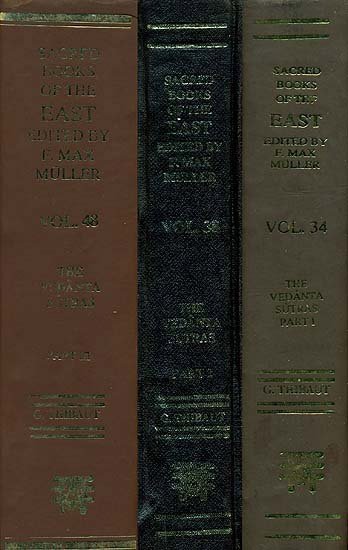Brahma Sutras (Ramanuja)
by George Thibaut | 1904 | 275,953 words | ISBN-10: 8120801350 | ISBN-13: 9788120801356
The English translation of the Brahma Sutras (also, Vedanta Sutras) with commentary by Ramanuja (known as the Sri Bhasya). The Brahmasutra expounds the essential philosophy of the Upanishads which, primarily revolving around the knowledge of Brahman and Atman, represents the foundation of Vedanta. Ramanjua’s interpretation of these sutras from a V...
Sutra 3.2.28
28. Or else in the manner stated above.
The but sets aside the two preceding alternatives. One substance may indeed connect itself with several states, but the former of the two alternatives implies that Brahman itself constitutes the essential nature of non-sentient matter, and thus there is no escape from the objections already stated under Sūtra 27. Let then the second alternative be adopted according to which Brahma-hood (brahmatva) constitutes a genus inhering in Brahman as well as in non-sentient matter, just as fire constitutes the common genus for light and luminous bodies. But on this view Brahman becomes a mere abstract generic character inhering in the Lord (isvara), sentient souls and non-sentient matter, just as the generic character of horses (aśvatva) inheres in concrete individual horses; and this contradicts all the teaching of Śruti and Smṛti (according to which Brahman is the highest concrete entity). We therefore hold that non-sentient matter stands to Brahman in the same relation as the one previously proved for the individual soul in Sūtra II, 3, 43; 46; viz. that it is an attribute incapable of being realised apart from Brahman and hence is a part (aṃśa) of the latter. The texts referring to the two as non-different may thus be taken in their primary sense; for the part is only a limited place of that of which it is a part. And the texts referring to the two as different may also be taken in their primary sense; for the distinguishing attribute and that to which the attribute belongs are essentially different. Thus Brahman’s freedom from all imperfection is preserved.—Lustre is an attribute not to be realised apart from the gem, and therefore is a part of the gem; the same relation also holds good between generic character and individuals having that character, between qualities and things having qualities, between bodies and souls. In the same way souls as well as non-sentient matter stand to Brahman in the relation of parts.
